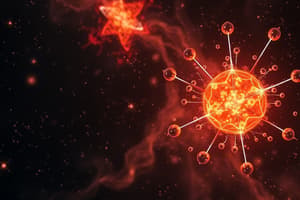Podcast
Questions and Answers
How were the light elements formed during the Big Bang?
How were the light elements formed during the Big Bang?
Light elements such as hydrogen and helium were formed during the Big Bang through nucleosynthesis.
What evidence supports the formation of light elements during the Big Bang?
What evidence supports the formation of light elements during the Big Bang?
Evidence includes observations of the cosmic microwave background radiation and the abundance of light elements in the universe.
How do stars evolve?
How do stars evolve?
Stars evolve through several stages, from stellar birth in nebulae to main sequence, then to red giant or supernova, and finally to remnants like white dwarfs, neutron stars, or black holes.
How were the heavier elements formed during star formation?
How were the heavier elements formed during star formation?
What evidence supports the formation of heavier elements during star formation?
What evidence supports the formation of heavier elements during star formation?
How do nuclear fusion reactions take place?
How do nuclear fusion reactions take place?
How are elements heavier than iron formed?
How are elements heavier than iron formed?
Flashcards are hidden until you start studying
Study Notes
Introduction to Nucleosynthesis
- Nucleosynthesis refers to the process of how elements were formed in the universe.
- The study explores the origins of elements, from light elements produced in the Big Bang to heavier elements formed in stars.
Essential Questions
- Formation of light elements during the Big Bang, supported by observable evidence.
- Evolution of stars and their lifecycle stages.
- Creation of heavier elements via nuclear processes in stars, with supporting evidence.
- Mechanisms of nuclear fusion reactions and their role in element formation.
- Formation of elements heavier than iron through specific astronomical processes.
Atomic Structure
- Atoms consist of protons, neutrons, and electrons.
- Protons and neutrons are located in the nucleus; electrons orbit around the nucleus.
- Each element is defined by its atomic number (Z), which corresponds to the number of protons in the nucleus.
Key Concepts in Nucleosynthesis
- Big Bang Theory: Initially proposed that light elements such as hydrogen and helium were created during this event.
- Stellar Evolution: Process by which stars generate energy and synthesize heavier elements through nuclear fusion.
- Nuclear Fusion: A fundamental process occurring in stars where lighter atomic nuclei combine to form heavier nuclei, releasing energy.
- Formation of Elements Heavier than Iron: This occurs through supernova explosions and other high-energy processes within stars.
Notable Quote
- Neill deGrasse Tyson emphasizes humanity's connection to the cosmos by stating that the atoms in our bodies originated from stars, capturing the profound relationship between humans and the universe.
Course Materials
- Structured lessons include objectives, warm-ups, key points, and interactive self-check activities.
- Each lesson in the unit covers various aspects of nucleosynthesis and stellar processes.
Additional Activities
- Laboratory activities to reinforce concepts of nucleosynthesis.
- Performance tasks designed to evaluate understanding of the formation of elements.
Key Terms
- Understand essential terminology relating to atomic structure, stellar processes, and nucleosynthesis fundamentals.
Studying That Suits You
Use AI to generate personalized quizzes and flashcards to suit your learning preferences.




